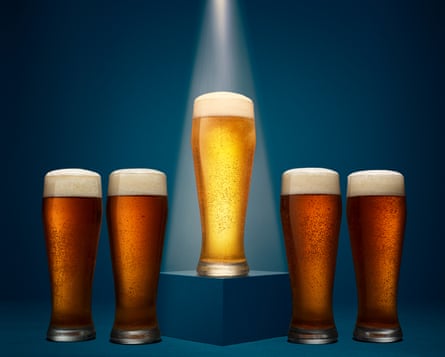We all know we should be snacking on blueberries and eating more leafy greens. But what should you do when you’re stuck at a motorway service station with a choice between crisps and more crisps? If you can’t resist a glass (or two) of wine, what’s the healthiest option? And is it possible to hit the kebab shop at 1am without being struck down by the spectre of Gwyneth Paltrow?
Not all junk food is created equal. Top nutritionists suggest the treats, booze and ultra-processed foods that pose the smallest risk to our health – and the ones even they eat from time to time.
The least processed crisps
Although nobody would count crisps as one of their five a day (a shame, because they are made from potatoes), if you swerve the flavoured options, some packets aren’t too bad as far as snacks go. “Look for an ingredients list that contains just potatoes and ideally extra-virgin olive oil and maybe sea salt,” says Dr Federica Amati, the author of Everybody Should Know This and the head nutritionist at the health science company Zoe. “You want them to be lightly salted, not very salted.”
Contrary to what you may think, those chickpea and lentil crisp alternatives might not be better for you, Amati says: “Read the back of the packet carefully as they might contain lots of additives, flavour enhancers and emulsifiers to make them taste good. You’re often better off having a simple, traditional crisp and not eating too many. Think Kettle Lightly Salted, or even Walkers Ready Salted, rather than Doritos Flamin’ Hot.”
Low-sugar sweets
Lots of gummies now claim to be “sugar-free” or “natural” and come in healthy-looking packaging, but is a saintly sweet an oxymoron? “Traditional gummy sweets and chewy candies are textbook UPFs and normally loaded with glucose syrup, artificial colours, flavourings and gelatine,” says nutritionist Rob Hobson, author of Unprocess Your Life. “Plain liquorice is a better option, but check the label as the proper stuff should only contain minimal ingredients such as molasses, flour and aniseed extract.”
For Amati, “a sweet is always a sweet, but opt for brands that don’t contain palm oil, which has a high saturated fat content. Candy Kittens and Biona are good examples. If you consume sweets in moderation and practise good dental health afterwards, they’re not too bad.”
Chocolate that’s good for you
“Dark chocolate typically contains less sugar than milk or white,” says the nutritionist Rhiannon Lambert, author of The Unprocessed Plate. “Opting for varieties with 75% cocoa or higher not only reduces the sugar content, it can also support a more diverse and flourishing gut microbiome. Dark chocolate is rich in polyphenols and antioxidants that may support heart health by improving blood flow and reducing inflammation.”
For bonus points, choose a dark chocolate with nuts in it. “Almonds or hazelnuts provide healthy fats, fibre and micronutrients such as magnesium and vitamin E,” says Lambert. But what if you’re not a fan of dark chocolate? “Choosing a milk chocolate bar that includes whole nuts can still be a more balanced option.”
Amati says you should still check the label on your dark and milk chocolate: “Look for cocoa butter or cocoa mass on the ingredients list, as some brands replace it with cheaper, more saturated fats. And avoid any additives, emulsifiers and sweeteners.” Vegetable or palm fats, lecithin, monoglycerides, and diglycerides of fatty acids are all red flags.
Gut-friendly drinks
We all know that fizzy drinks are full of sugar, artificial sweeteners and other additives, but sometimes nothing hits the spot like a cold can of pop. “There are now lots of probiotic soft drinks on the market,” says Amati. “The jury’s still out on how effective they are for gut health, but many of them are low in sugar and have no artificial sweeteners or added sugar, making them a good option.”
Hobson says swapping standard fizzy drinks for kombucha (fermented tea) is a smart move: “Opt for varieties with live cultures, that are unpasteurised and with no added sugars.” He favours Momo Kombucha (“It’s raw unfiltered and brewed in small batches with organic ingredients”), and Remedy Kombucha (“It’s fermented to the point where sugar is virtually eliminated”). Other kombucha brands with low sugar content include No 1 Living, Holos and Jarr.

The least calorific lager
They don’t call it the “beer belly” for nothing, but is it possible to sip a pint without derailing a diet? “Lagers that have ‘light’ in their name, or low-alcohol beers, are generally your best bet,” says Lambert. “That’s because the majority of calories in beer come from its alcohol content – the higher the alcohol by volume (ABV), the more calories it tends to contain. For example, a standard lager contains about 150–200 calories per pint, while a low-alcohol or light lager can come in closer to 80–100 calories.
These options still offer the refreshing lager taste, just with fewer calories and often less impact on hydration, and sleep too. If you’re watching your intake, always check the ABV and aim for beers that are around 3% or lower.” Small Beer makes a lager that’s 2.1% and only 73 calories a can.
The wine least likely to give you a hangover
It was bad news for the “everything in moderation” brigade when a 2022 study found that even a small amount of alcohol has negative health outcomes. But if you are going to have a glass of wine, is there a grape that’s less grim than the others? “Hangovers are usually the result of a toxin called acetaldehyde (the byproduct of alcohol breakdown), dehydration and compounds called congeners, which are more prevalent in darker and cheaper wines,” says Hobson. “It’s for this reason that white wine gives you less of a hangover than red. Sulphites often get the blame, but unless you’re genuinely sulphite-sensitive, they’re unlikely to be the problem.”
after newsletter promotion
However, organic or biodynamic wine does tend to have fewer additives overall, and often lower levels of sulphites and residual sugar, so they can be a better choice. Wines from cooler-climate regions such as the Loire valley or parts of Germany are usually lower in alcohol (11-12%), and you can now buy specially made low-alcohol wines that can make a difference to your hangover. It’s also a good idea to go for dry wines rather than sweet ones, as less sugar can mean less of a headache the next day.”
But, ultimately, it’s about pacing yourself, not drinking on an empty stomach and drinking water alongside alcohol. “Even the cleanest, most ‘natural’ wine won’t save you from a hangover if you drink too much,” says Hobson.
The fizzy wine with the least sugar
Beware the bubbles – fizz has been proved to cause worse hangovers than any other kind of wine. But if you want to raise a toast, which is the best for you? “The fizzy wines labelled Brut Nature or Extra Brut contain the lowest levels of residual sugar – typically under 6g per litre,” says Lambert. “Whether it’s prosecco, champagne or cava, choosing one of these dry varieties is your best bet. Avoid styles such as demi-sec or doux, which have a much higher sugar content.”
The best of the breakfast cereals
Breakfast cereals get a bad rep on the UPF front, but some are much healthier than others. “Yes, Weetabix is technically a processed food, but it’s low in fat, high in fibre, affordable and delicious,” says Amati. “About 90% of adults in the UK are fibre-deficient and breakfast cereal is an easy way to up your intake.” Amati also favours Dorset Cereals and jumbo steel-cut porridge oats. “Making it in the microwave is fine,” she says. “Just avoid quick-cook oats (as these have been more processed and so make your blood sugar spike) or flavours or sweeteners.”
And beware of that healthy-looking granola – it may not be as good for you as you think. “Many are heavily processed and contain high levels of added sugar, emulsifiers and refined grains,” says Lambert. “Opt for ones with a low sugar content – ideally less than 5g of free sugars per 100g – and made from whole ingredients such as oats, nuts, seeds, maple syrup or honey, and dried fruit.” Bio&Me Granola has just 4.2g of sugar per 100g, compared with 15g in the same amount of Jordans Simply Granola.
The most virtuous takeaway
Not all takeaways have to come with a side order of guilt. “In general, avoid deep-fried food,” says Amati. “Some places cook in saturated fats and keep reusing the same oil.” Instead, head towards your local Thai, Vietnamese or Indian restaurant. “Choose the veggie option, such as a chickpea, paneer or spinach curry. These are all fibre-rich, whole foods.” And don’t order the rice. “It’s much better – and cheaper – to make rice at home using packets of parboiled rice you can buy in the supermarket. When you reheat cooked rice the starch is more resistant, which is better for blood sugar control and improved gut health.”
Hobson favours a Turkish takeaway. “I would go for a grilled chicken shawarma wrap with salad, hummus and a wholemeal flatbread,” he says. “This option is balanced with lean protein, fibre and healthy fats. These kind of places often offer fresh vegetable and grain-based salads such as tabbouleh, bulgur salads or ezme, which are rich in fibre and other key nutrients.”
The best pre-packaged sandwich
Those chilly, limp pre-made sandwiches are never the most satisfying, but if you have to grab one, which is the lesser of the UPF evils? “Look for those made with wholegrain or seeded bread, as they provide more fibre and keep you fuller for longer than white bread,” says Lambert. “For the filling, lean protein such as falafel, hummus, chicken, egg or tuna are all good options, especially when paired with salad or crunchy vegetables. Creamy sauces, excessive mayonnaise or cheese-heavy fillings can push up the saturated fat and salt content up quite significantly, so it’s worth being selective.”
If in doubt, focus on fibre. “The nutrient most of us are probably deficient in is fibre, so if you’re checking the nutrition label, check the fibre content, and try to pick one that gets you as close as possible to 3g of fibre per 100g. It’s a helpful benchmark for knowing you’re getting a more satisfying, gut-friendly choice.”

.png) 2 months ago
54
2 months ago
54

















































